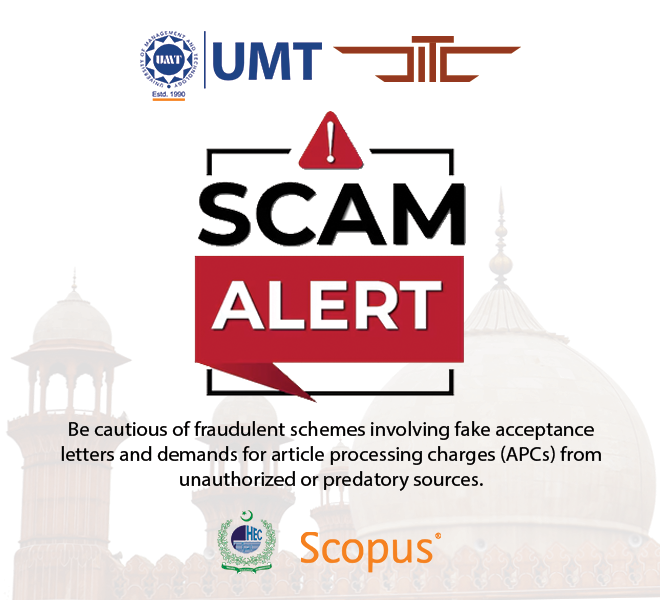Taubat-un-Nasooh: Religious implications among families of 19th century Ashrafia of colonial India
Abstract
 Abstract Views: 127
Abstract Views: 127
Nasooh starts the discussion on religious matters as is the trend in traditional Muslim families of Ashraf. His way of thinking had already seen a sea change. The reason behind this mental transformation is his dream, but after observing the spoiled ways of his home he did not mention these religious issues in front of his siblings. The character of Nasooh as the head of the family of Ashrafia, represented the conventional school of thought. Nazir Ahmed highlighted the sociopolitical circumstances of Ashrafia and their religious state of mind, doubts and misunderstanding of the youth of the Ashrafia about religion in those times.
Downloads
References
Nazeer Ahmad regarding education and reformation of the
Muslim Ashrafia. There is contradiction about the year of
publication of Tubat-ub-Nasooh among the Urdu critiques. It is indicated from the preface of Binat –un-Nash
that Nazeer Ahmed already had its outline in his mind and
he wanted to write a story regarding the kids training and
religious education. That’s why in the last lines of Binatun
Nash he promised that: “If I have still life ahead and find
some leisure time then Inshallah I will present the readers
another book next year and that story will be presented in
that book.”According to this project, he published Tobatun-Nasooh in 1873 and in the same year he presented it
for the government prize. Its first edition was published in
Agra but the strange thing about it was that there was tremendous contradiction in this publication. In Hayat-eNazir, there is only indication of place of publication as
Azam Garh. In book Dastan-e-Tareekh-e-Urdu the year of
publication of Tobat-un-Nasooh is mentioned as 1877. In
recently published books and columns the year of publication written is also wrong. For example, in a column of
‘Urdu Nama’ second edition by Begum Shaista, the complete list of the publication of Deputy Nazeer Ahmed, the
date of publication of Tobat-un-Nasooh in the twelfth line
is 1877. Dr Syed Latif in the thesis of his PhD, ‘Rattan
Nath Sarshar Ki Novel Nigari’, has written 1877 as the
date of publication of Tobat-un-Nasooh. Professor Akhter
in his column ‘Fun Novel Nigari’ and Nazeer Ahmad
Dehlavi, the place where he has given the list of Nazeer
Ahmad novels, indicated 1866 as the year of publication
for Tobat-un-Nasooh. Dr Sohail Bukhari writes that Tobat-un-Nasooh was written in 1877. In 1873, when Tobatun-Nasooh was presented for the government prize, Mr
Campson as the Mayor of North and West Province, wrote
detailed comments on it and referred it to the government
for first prize. This commentary was published in 1874 as
37 reminders in the edition of the government gazette and
at the end of that the date written is 1873. Sir William
Mayor, as lieutenant governor of north and western province, announced a prize for it with a strong liking, and the
date written on that is 17 January 1874. In the initial editions of Tobat-un-Nasooh, the detailed commentary of Mr
Kampson and William Mayor has been published in government gazette. Professor Garsan De tasi also indicated
Tobat-un-Nasooh in his address of 1874. This has been
proved from the creative effort done by Dr Mohammad
Sadiq that the extract of Nazeer Ahmed, knowledge is
from the Danial Defoe novel ‘Family Instructor’. Nazir
Ahmed in his preface did not mention any of this fact but
it seems that the religious perspective of the novel indicates his own religious thoughts (values). Dr Mohammad
Sadiq indicated this while commenting a little bit on the
English extracts of Tobat-un-Nasooh, on the novels written by Nazeer Ahmed under the caption of ‘Nazir Ahmed
Aik Jaeza’, in the edition of magazine ‘Mahe No’o’ in
May 1951.
2
(Saksena 1975,9)
3 Nazir Ahmed, Tubat-un-Nasooh, (Lahore: Feroz Sons,
1988) for detail see Chapter -1.
4
Ibid. chapter no 2 reflects the changed attitude of Nasooh
and he calls all the family Members to convey his religious issues.
5
Ibid, 45.

This work is licensed under a Creative Commons Attribution 4.0 International License. Authors retain copyright and grant the journal right of first publication with the work simultaneously licensed under a Creative Commons Attribution (CC-BY) 4.0 License that allows others to share the work with an acknowledgement of the work’s authorship and initial publication in this journal.








